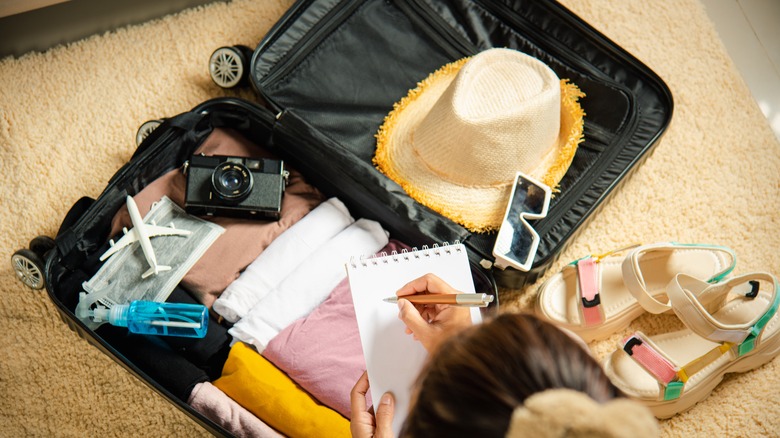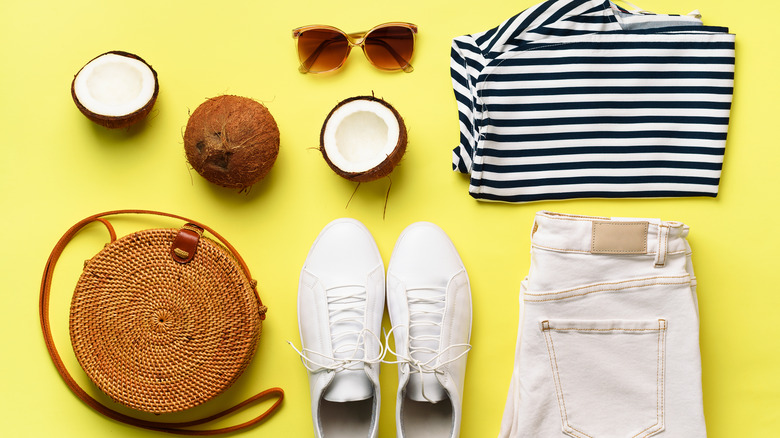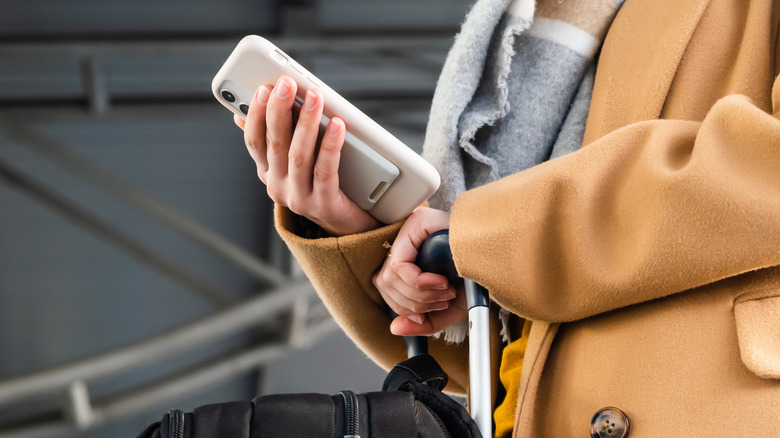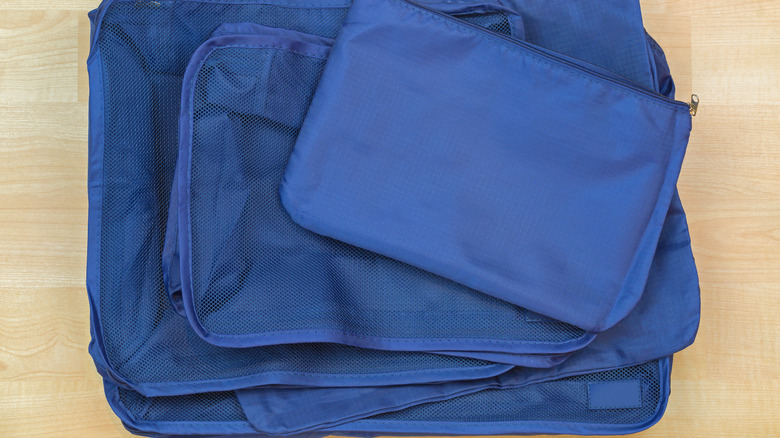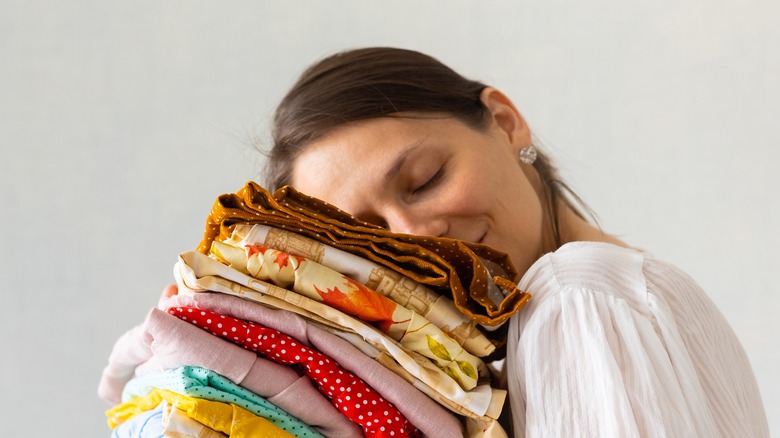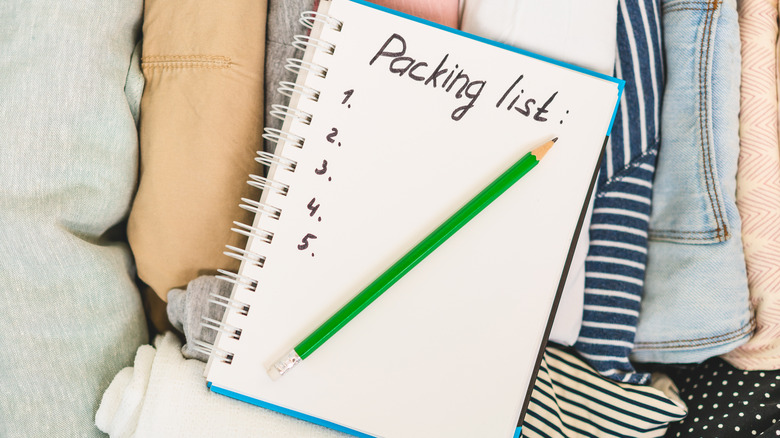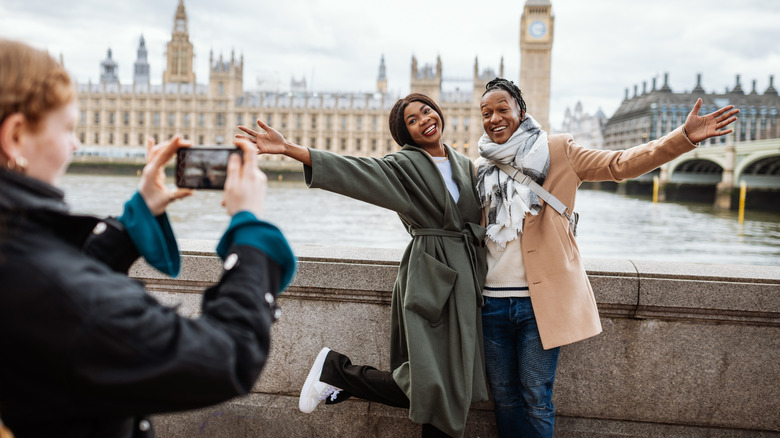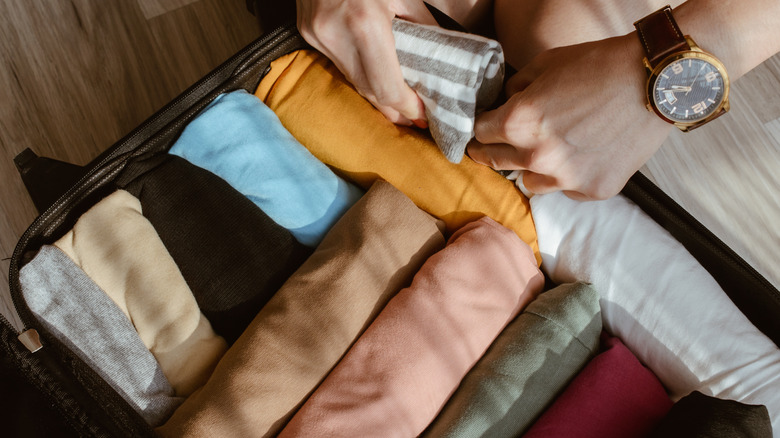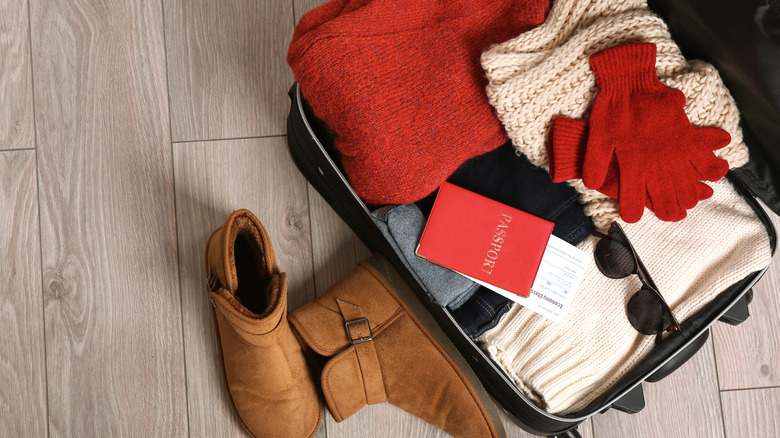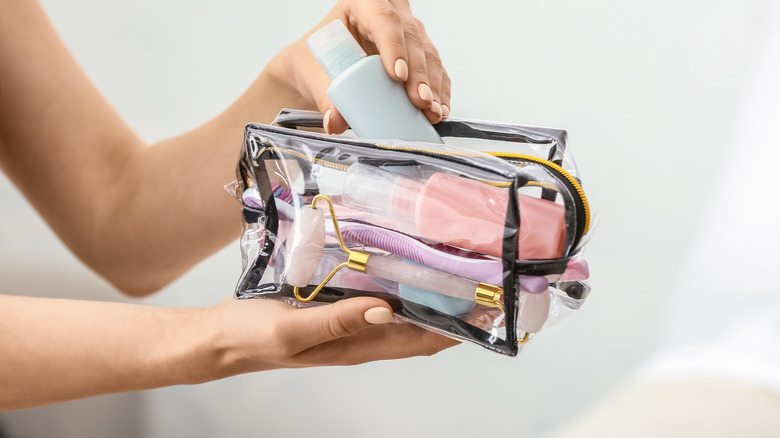The Complete Guide To Packing Light
Packing light is a skill travelers learn over time, though it's becoming more and more crucial to pack smart. Given how notorious airlines have become for losing checked bags, it's time to practice if you haven't mastered the art of packing light. Ending up as one of the unlucky ones who don't get their luggage at the carousel is a tedious event. Generally, airlines will lose around seven out of 1,000 bags which is a little under 1%, according to Simple Flying. So while it's not a super common occurrence, not having your belongings is a rough way to start a vacation.
You could hope for luck by flying budget airlines like Frontier or Allegiant (who somehow have the best track record for not losing bags) or finesse your packing skills to become a carry-on-only or backpack-only traveler. Not only will you save time by not having to go to baggage claim, but you'll also save money on bag fees with airlines and make it easier to get around. There are so many reasons why minimalistic packing makes for a more stress-free travel story.
Once you get the hang of packing smarter, going light on your luggage becomes more of a game than a chore. Can you fit less in the carry-on this time? Have you mastered the art of the clothing bundle roll? Perhaps these skills will inspire you to backpack for a month in Europe without fear of leaving something behind.
Follow the 1-2-3-4-5-6 rule
Even if you're packing for more than a week, expert travelers swear by the 1-2-3-4-5-6 packing rule to keep their packs light. Daniel Green of Faye told Business Insider that he follows the rule and explained it this way: "Pack one hat, two pairs of shoes, three bottoms, four tops, five pairs of socks, and six pairs of underwear." By following these parameters, you're less likely to overpack your clothes. Don't forget to bring other items as your personal needs facilitate like bras, swimsuits, ponchos, or other clothing needs.
The 1-2-3-4-5-6 rule essentially creates a capsule wardrobe in your luggage. You'll want to pack pieces you can mix and match rather than trying to pack entire separate ensembles for your travels. Not only does this save a lot of room in your suitcase, but it can also help pair down your closet in the process.
Generally, the rule applies for trips up to two weeks, though you can easily live with the clothing limit by doing laundry throughout your trip if it's longer. Even if you don't follow the rule, don't pack more than a week's worth of clothing. Even by following that parameter, you'll be packing lighter than if you try to fit in a ton of clothes without planning it out.
Wear your bulky items
From boots to puffy coats, wearing your bulkiest items on the plane means less stuff to cram into your luggage. You don't have to wear the coat the whole time, but if you keep it on your person it won't be taking up a ton of space in your suitcase. Plus, a fluffy coat or big sweater can make a great makeshift blanket or pillow Just don't be that person who crams their coat in the overhead bin during boarding, creating less space for everyone else's luggage.
If you'd rather not wear your bulky pieces on the plane or carry them along, there are ways to pack them. Lay bulky clothing items like sweaters with a thinner shirt on top and rolling them together for packing. To keep the bundle together, you can secure it in its shape with a rubber band. Not everything saves space by rolling, however. So it's OK to try rolling or folding to see what works best for your pieces. Different modes of condensing your clothes are particularly important if you use organizational products like packing cubes because your items have to fit into that confined space with everything else. So experiment with techniques to see what works for your unique packing style.
Utilize packing cubes
Packing cubes aren't just a trendy way to keep your luggage organized. In fact, they are an incredible way to reduce the space your clothing occupies in your luggage by compressing it together. You can't plan on packing your entire closet, but packing cubes certainly help with minimalist packing strategies.
Dividing up your items into different packing cubes is also an excellent way to keep track of your things in a suitcase. If you have all your undergarments in one cube, with clothes in another, you'll save yourself from digging around trying to find a rogue sock. Having more than one packing cube also means you can put your dirty clothes in them as you go to keep your worn clothes away from the rest of your belongings.
You could also opt to use space-saver compression bags or even compressed Ziploc bags too. A plus to using vacuum seal compression bags is that they're often see-through, so you know what's in the bag and they compress significantly more than packing cubes. Still, that can lead to overpacking too, so it's a delicate balance between efficiency and overabundance. No matter what you choose, compartmentalizing your luggage is a great way to cut down on space.
Consider washing after wearing
Travelers who are planning on more than a week of suitcase living might be worried about running out of clothes. Even if you won't have access to washing or laundry services while you're traveling, it's still fairly easy to wash your clothes by hand in your accommodation. Through some pre-planning, you can be prepared to wash your clothes after you wear them to refresh them ahead of wearing them again.
Washing by hand in a hotel is all about timing, but there are ways to help speed things along. Traveler Catherine Luciano told the Los Angeles Times when she hand washes something on the go, she leaves it to dry overnight in the bathroom with the exhaust fan on, which nearly always leaves the item dry the next day. Another option is to carefully place your items to dry on a hotel balcony if you have one or utilize an in-room laundry line if there is one.
If you plan on hand washing your clothes, be sure to keep that in mind while you're packing. Consider bringing clothes that are going to dry more efficiently. Those items tend to be ones made from quick dry fabric varieties like polyester and nylon. Natural fibers like cotton can take longer to dry, so keep that in mind when washing. Perhaps wear those items early on to give the laundry time to dry. No one wants to open a suitcase with damp, musty clothes in it after a holiday.
Leave the maybe pile
There's a good chance that if you're thinking about packing something "just in case," you won't need that item. Should you need it after all, you can probably buy one wherever you are traveling to. The truth is, the "just in case" items aren't usually essential for day-to-day life even when you're traveling, so it's usually better to just leave them behind.
Lay out everything you think you'll need for your travels and then removing half of those items to reduce your pack. That way, you really get a sense of what is really essential for your upcoming adventure. Lara Fielding told Vox that part of the reason we're tempted to overpack is to compensate for the new environments we're going to. Having more of our familiar belongings brings normalcy, though we don't really need them. It's OK to feel drawn to bringing more than you need, it's a natural response to change. But over time and with more travel experience, the maybe pile becomes less of a packing habit default.
Stick to your list
When you get ready to pack for your trip, find or create a packing list that applies to your destination. When having a list to stick to, you're less likely to overpack because you have an idea of what you actually need to bring. Think of it like going to the grocery store with a list versus just winging it.
Sometimes having categories in the list can help with organizing your luggage while also ensuring you aren't missing anything important. By creating sections for your clothes, hygiene products, and even technology pieces, you can make sure you aren't leaving behind your charging cables or your sunscreen. If you're a compartmentalized packer it also helps divvy up where your products are, such as tech in a black pouch or makeup in the silver bag.
You don't necessarily have to write your own list, there are plenty of templates online for every kind of vacation from Antarctic expeditions to luxurious forays in Bali. Find one or make one that suits your needs. Consider saving the list too so you can use it again for your next adventure!
Pack items that do double duty
Bringing reversible clothes, multi-functional tools, or shoes that work for daytime outfits or night-out excursions are ways savvy travelers cut down on packing. When you utilize items that pull double duty, you're freeing up room for something else in your suitcase. Some of those items could also include multi-functional swimwear pieces, using a fluffy jacket as a pillow instead of bringing a travel pillow, or bringing an oversized scarf or pashmina as a travel blanket.
Clothes are far from the only double-duty items that could be in your arsenal, however, so don't discount your hygiene products. Utilize items like face tints that you can use for your cheeks or lips or ointments that can go on everything from chapped lips to sunburned features. Coconut oil is another great option with myriad applications from skin nourishment to even makeup removal. Anytime items can pull double duty, you're saving space in your luggage. So if you have a skin product that you feel is good for everything, that might be your best travel skin item.
Plan to dress with layers
Packing clothes that can be mixed and matched means also having pieces you can layer together. Even if you're going somewhere warm, consider packing a coverup or something you can put on if it gets chilly or the air conditioner is too much. Layering is a great way to utilize what you already have instead of packing a whole separate outfit. Not to mention that you'll be more prepared for the unexpected.
Choosing something like a long sleeve shirt to wear over what you already have on or a lightweight jacket can take up much less space than a bulky sweater. It can be easy to pack a layer or two without doubling the number of clothes in your luggage. Choosing a bonus layer to bring based on its material is also a great idea. A thin, merino wool sweater, for example, will keep you cozy even if it isn't thick. Packing with layers in mind may also save you from spending an exorbitant amount of money for a sweatshirt at the hotel gift shop, which would definitely add to your suitcase's bulk.
Redistribute your packing space
Sometimes how you pack your suitcase is as important as what you pack in it. From rolling your clothes or folding them to keeping the heaviest items on the bottom to redistribute the weight, there are a lot of ways to more efficiently pack. Try a combination of rolling and folding methods for the best luggage space saving. Stick to rolling softer clothes like cotton t-shirts but fold stiffer fabrics.
There are two more lesser-talked-about packing techniques too: the wrapping method and the bundling method. Each method is fairly simple. Use the wrapping method for longer pieces like dresses, which you place at the bottom of the suitcase with the top and bottom hanging off the sides. Once you get all your clothes in the suitcase, you simply wrap the rest of the garment around the packed pieces. Not only is this space-saving, but it also helps reduce wrinkles too!
As for the bundling method, you fold different pieces over one another. For example, you put your socks inside of a shirt which is wrapped with a pair of pants. Do this to keep outfits together while saving space at the same time.
House items in other items
Anytime you pack something like an empty shoe or boot in your suitcase, you're wasting valuable space. These items are the easiest to repurpose inside your luggage because they have space to give. Have you considered storing some or your small items, like socks, inside your shoes or boots? The space stays the same either way.
Even if you aren't putting anything inside your shoe, you can fill the gaps between the heel or around the shoe with other things like a tightly packed shirt. Placing objects like socks inside the shoes saves space, but it also protects the shoe's shape as well so you don't end up with squashed sneakers or boots. Depending on the size of your shoe, you might be able to fit a small pouch in there too or a miniature jewelry case. When trying to pack efficiently, every little space counts, so stuff those shoes!
Pack fewer toiletries
Especially if you don't have special hair, scalp, or skin needs, you can easily leave behind some of those pesky toiletries. Hotels give you shampoo, conditioner and body wash or soap during your stay which make these items less necessary to pack. If you're traveling with companions, you can all share certain toiletries during your travel to save you all some space in your luggage.
One way to trick yourself into packing fewer toiletries is to get a smaller toiletry bag. If you don't have as much room to shove more items into, you're less likely to overpack on non-essential hygiene products. While you're packing, consider how much product you use on a day-to-day basis. You are probably not going to need four mini bottles of shampoo per person for a week long vacation. Only pack what you know you'll use, but don't fall into the "just in case" trap.
When travel becomes a long haul endeavor (like several weeks or months) it might even be better to just buy toiletry products at your destination rather than trying to pack them. A single, regular sized bottle of shampoo is going to be less cumbersome than twelve mini bottles jammed into your TSA-approved toiletry bag.
